6. Working with Date, Time, and Calendar
In this chapter, you find out how to set the time, use the Clock application, and use the Calendar application. Topics include the following:
→ Synchronizing to the correct time
→ Working with the Clock application
→ Setting alarms
→ Waking up with the latest weather, news, and your schedule
→ Working with the Calendar
Your Galaxy Note II has a Clock application that you can use as a bedside alarm. The Calendar application synchronizes to your Google or Microsoft Exchange calendars and enables you to create meetings while on the road and to always know where your next meeting is.
Setting the Date and Time
Before you start working with the Clock and Calendar applications, you need to make sure that your Galaxy Note II has the correct date and time.

2. Touch Date and Time.

3. Touch to enable or disable synchronizing time and date with the wireless carrier. It is best to leave this enabled as it automatically sets date and time based on where you are traveling.
Does Network Time Sync Always Work?
In some countries, on some carriers, time synchronization does not work. This means that when you get off the plane and turn Airplane mode off (see the Prologue, “Getting to Know Your Galaxy Note II,” for information on Airplane mode), after a reasonable amount of time your time, date, and time zone will still be incorrect. In these instances, it is best to disable automatic date and time and manually set the time, date, and time zone yourself, and try it on automatic in the next country you visit or when you are back in your home country.
4. Touch to set the date if you choose to disable network synchronization.
5. Touch to set the time if you choose to disable network synchronization.
6. Touch to enable or disable synchronizing the time zone with the wireless carrier. It is best to leave this enabled as it automatically sets the time zone based on where you are traveling.
7. Touch to set the time zone manually if you choose to disable network synchronization.
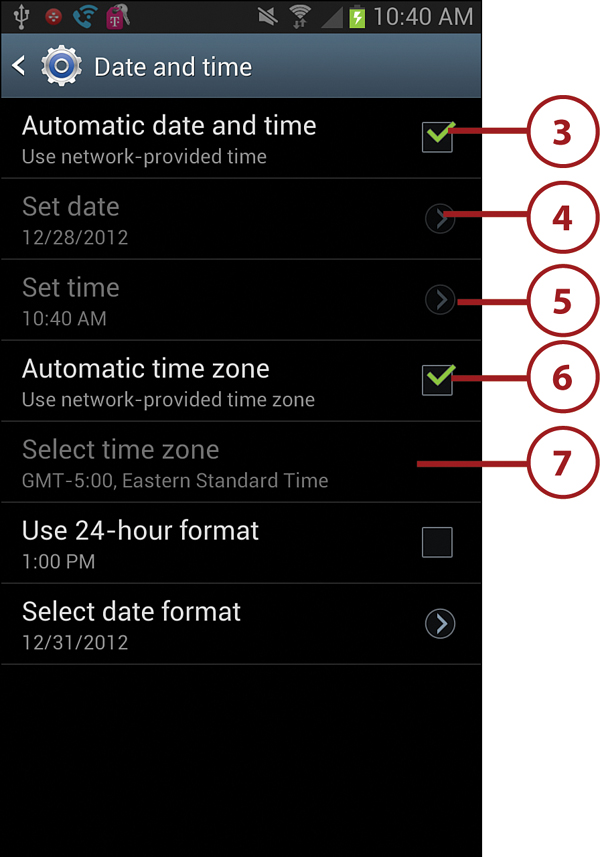
8. Touch to enable or disable the use of 24-hour time format. This format makes your Galaxy Note II represent time without a.m. or p.m. For example, 1:00 p.m. becomes 13:00 in 24-hour format.
9. Touch to change the way in which the date is represented. For example, people in the United States normally write the date with the month first (12/31/2010). You can make your Galaxy Note II display the date with the day first (31/12/2010) or with the year first (2010/12/31).
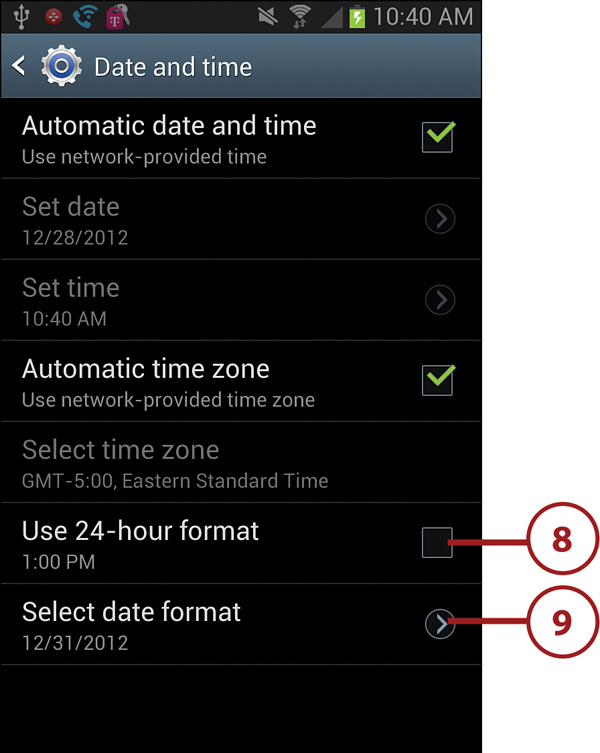
Clock Application
The Clock application is preinstalled on your Galaxy Note II and provides the functionality of a bedside clock and alarm clock.
Navigate the Clock Application
1. Touch the Clock icon.
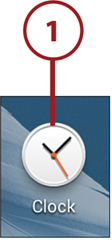
2. Touch to create an alarm.
3. Touch to view and edit your alarms.
4. Touch to see the World Clock and manage the clocks on that screen.
5. Touch to use the Stopwatch.
6. Touch to use the Timer.
7. Swipe right to see the Desk Clock function.
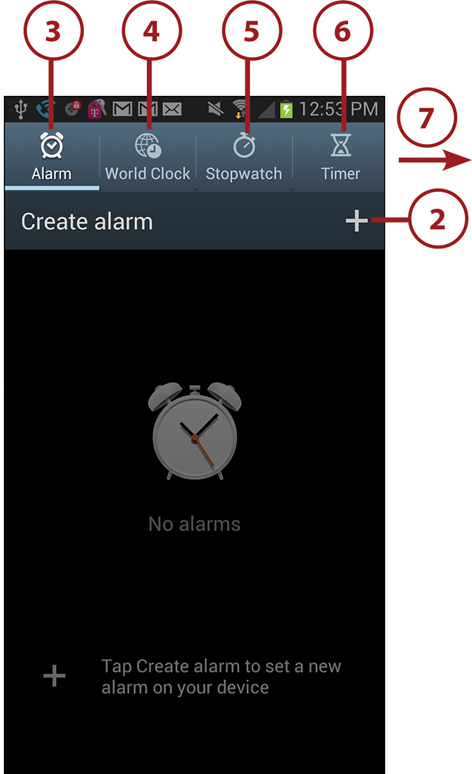
Manage Alarms
The Clock application enables you to set multiple alarms. These can be one-time alarms or recurring alarms. Even if you exit the Clock application, the alarms you set still trigger.
1. Touch to create a new alarm.

2. Use the up/down arrows to set the hours and minutes.
3. Touch to toggle between a.m. and p.m.
4. Touch the days of the week when you want the alarm to trigger. In this example, the alarm will sound on all days of the workweek but not on Saturday and Sunday.
5. Check this box if you want the alarm to repeat every week.
6. Touch to change the type of alarm. Your choices are Melody, Vibration, Vibration and Melody, and Briefing.
What Is Briefing?
If you choose the Briefing alarm type, you are awakened by the sound of the melody you chose to play, but your Galaxy Note II also reads you the weather, news of the day, and any appointments you have for that day.
7. Touch to see more alarm settings.
8. Scroll down to see the extra settings.


9. Slide to adjust the volume of the alarm.
10. Touch to change the alarm tone or melody that plays.
11. Touch to enable or disable Location Alarm. If you enable this, you are setting the alarm to only trigger when you are at the chosen location.
12. Touch to enable or disable the Snooze feature and set how long the snooze lasts.
13. Touch to enable or disable Smart Alarm. Smart Alarm plays a tune ahead of the alarm time to slowly start waking you up.
14. Touch to give the alarm a name.
15. Touch to save your new alarm.

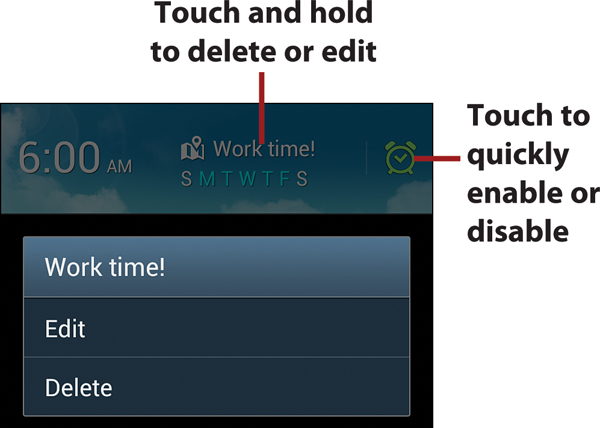
Editing or Deleting an Alarm
To edit or delete an alarm, touch and hold the alarm you want to edit or delete. When the pop-up window appears, make your choice. If you just want to quickly enable or disable an alarm, touch the Alarm Clock icon on the far right of an alarm.
Use the World Clock
The World Clock enables you to keep track of time in multiple cities around the world.
1. Touch to see the World Clock.
2. Touch to add a new city.

3. Type in a partial city name to find the city you want to add.
4. Touch a city to add it to the World Clock screen.


Managing Cities
To delete a city from your World Clock screen, or to rearrange the cities you’ve saved, touch the Menu button and choose Delete to select which cities to delete or Change Order to rearrange them.
Use the Desk Clock
You can manually select or automatically launch the desk clock when you insert your Galaxy Note II into a Samsung dock. This mode turns the Clock app into a desk clock or a bedside clock.
1. Swipe to the right.
2. Touch Desk Clock.

3. Touch to enable Dock mode. Read more about Dock mode in the next section.
4. Touch the Menu button to see the Settings menu item.
5. Touch to adjust the settings for the desk clock.

6. Touch to enable or disable displaying the calendar on the Desk Clock screen.
7. Touch to enable or disable displaying the weather on the Desk Clock screen.
8. Touch to choose Fahrenheit or Celsius and whether the weather is periodically updated.
9. Touch to adjust the settings for Dock mode. The next section covers the Dock mode settings.
10. Touch to save your changes and return to the Desk Clock screen.

Use Dock Mode
You can manually switch the desk clock into Dock mode, or Dock mode can be automatically activated when you insert your Galaxy Note II into a Samsung dock.
1. Touch to enable Dock mode (or insert your Galaxy Note II into a Samsung dock).

2. Touch to exit Dock mode and return to the desk clock.
3. Touch one of the shortcuts to launch the associated app.

4. After one minute, the screen dims, and just the date, time, and weather are displayed. The screen dims based on the light in the room.

Change Dock Mode Shortcuts
You can add or remove shortcuts in Dock mode, which allows you to have quick access to the apps you need.
1. Touch the Menu button.
2. Touch Edit Shortcuts.

3. Touch to remove a shortcut.
4. Scroll to the right.
5. Touch to add a new shortcut.
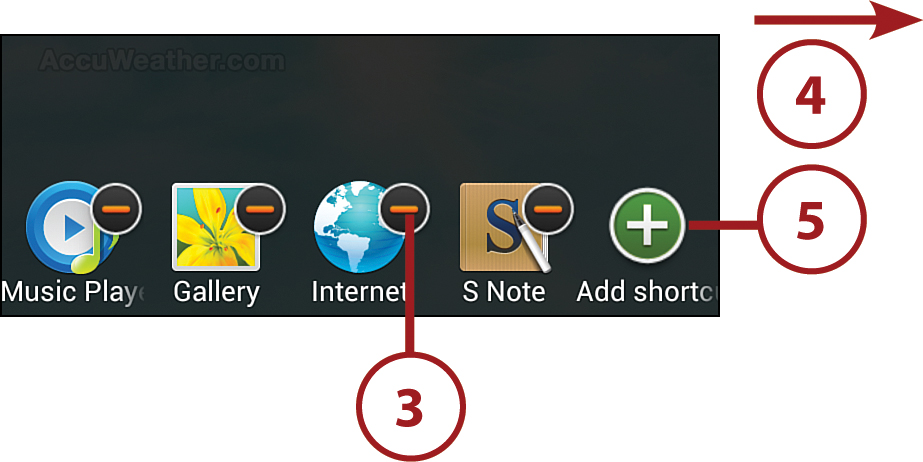
6. Scroll down to see all available apps.
7. Touch to select an app to create a new shortcut.
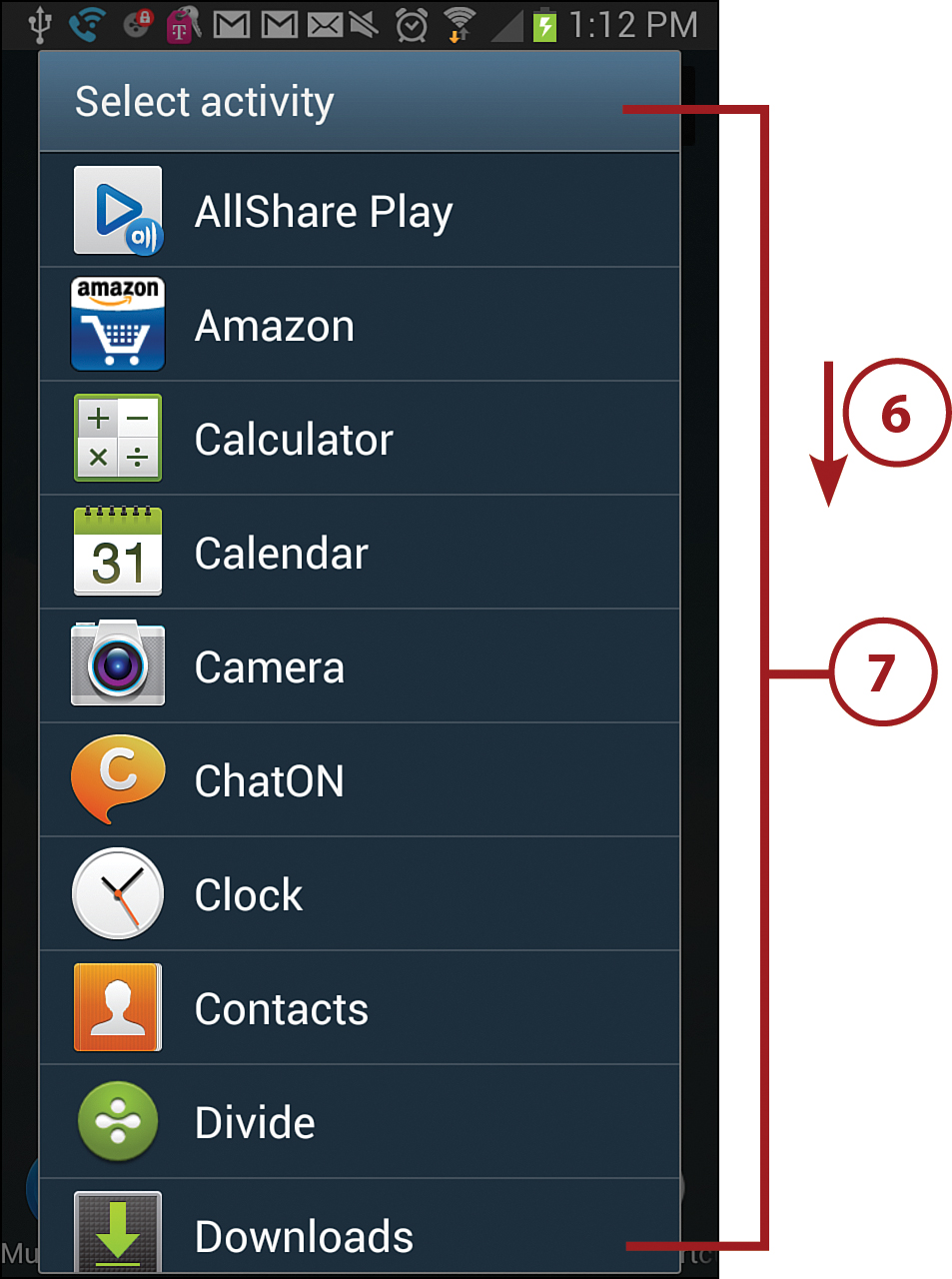
Change Dock Settings
You can control how Dock mode works, and because the physical dock (if you have one) has ports for USB and audio, you can set how audio is output.
1. Touch the Menu button.
2. Touch Settings.
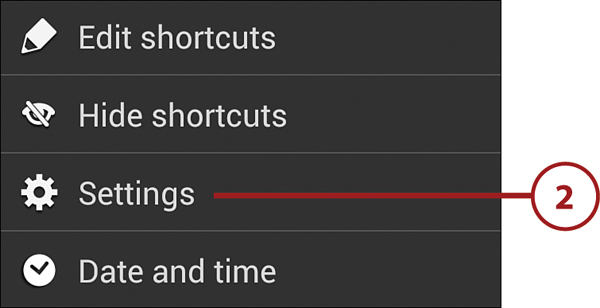
3. Touch to hide the status bar when in Dock mode.
4. Touch to choose the background. You can choose the default Dock wallpaper, choose an image from the Gallery app, or set it to use whatever you have chosen as the wallpaper for your Home screen.
5. Touch to enable or disable showing the Calendar in Dock view.
6. Touch to enable or disable showing the weather on the Dock screen.
7. Touch to choose Fahrenheit or Celsius and whether the weather is periodically updated.
8. Touch to set the brightness manually, or leave it set to automatic.
9. Touch to change settings relating to the physical dock.

10. Check the box to disable playing a sound when you insert your Galaxy Note II into the dock.
11. Touch to enable or disable using external speakers connected to the dock when docked and playing audio.
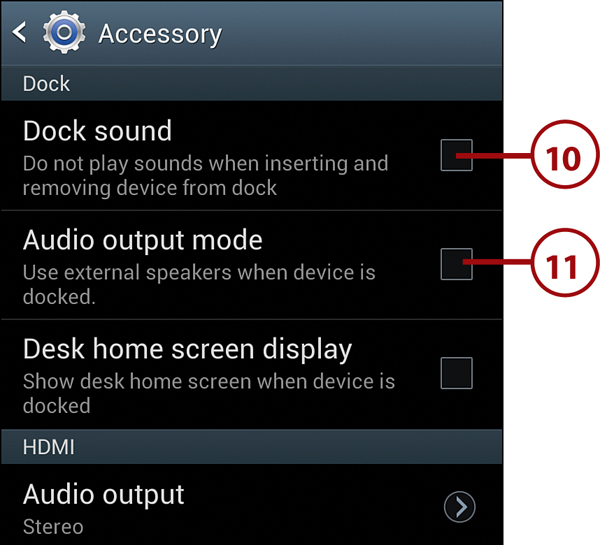
12. Touch to enable or disable automatically showing the Dock screen when you insert your Galaxy Note II into the dock. If unchecked, you just see the regular Home screen.
13. Touch to choose what kind of audio is output via the High-Definition Multimedia Interface (HDMI) cable when docked. You can choose Stereo or Surround.
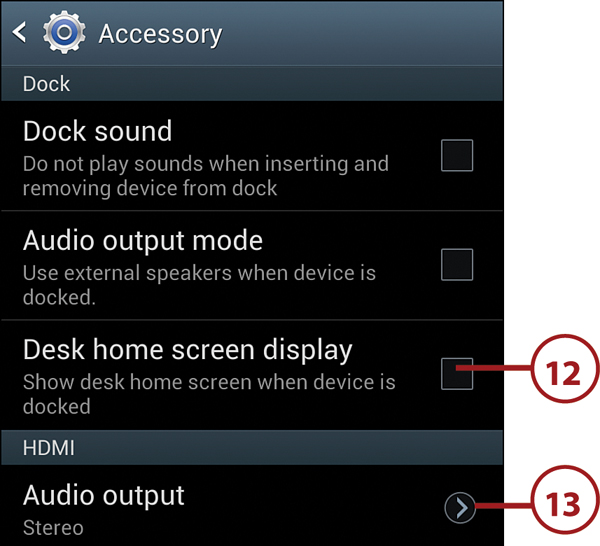
14. Touch the Back button to save your settings and return to the Dock mode settings.
Using the Calendar Application
The Calendar application enables you to synchronize all of your Google Calendars under your primary Google account to your Galaxy Note II. You can accept appointments and create and modify appointments right on your phone. Any changes are automatically synchronized wirelessly back to your Google Calendar.
Navigate the Calendar Main Screen
The main screen of the Calendar app shows a one-day, one-week, or one-month view of your appointments. The Calendar app also shows events from multiple calendars at the same time.
1. Touch the Calendar icon.
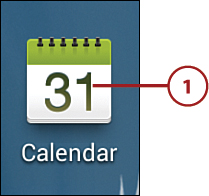
2. Swipe left to go backward in time.
3. Swipe right to go forward in time.
4. Touch to show today’s date.
5. Touch to have the Calendar view choices slide in from the right.
6. Choose a Calendar view.
7. Touch to switch to Writing mode, where you can draw over the calendar with the S Pen.
Drawing All Over Your Calendar
Instead of adding events to your calendar, you can just draw on the calendar as if it was a wall calendar or a page in a notebook. This feature only works when you are viewing the Month view and you are holding your Galaxy Note II in portrait orientation. When you switch into Writing mode as described in step 7, you can draw anything anywhere on the month. This is simply free-form drawing and is not translated into real events in your calendar; however, it’s an easy and creative way to mark the calendar for yourself.
8. Touch to create a new event.
9. Touch to choose which calendars to display simultaneously.
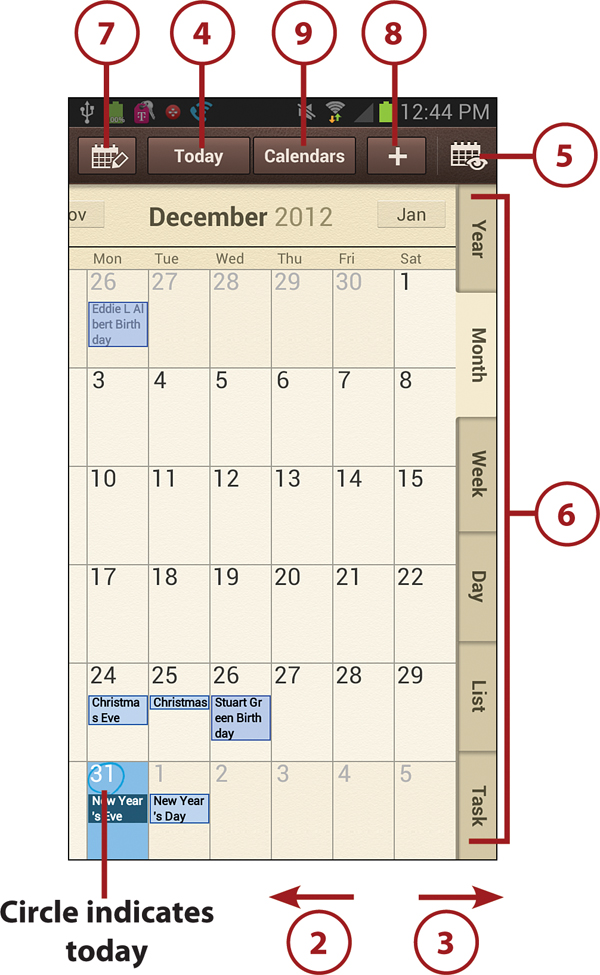

Event Colors
The Calendar app can display one calendar or many calendars at the same time. If you choose to display multiple calendars, events from each calendar are color coded so you can tell which events are from which calendar.
Choose Which Calendars and Task Lists to View
If you have set up multiple accounts, which might each have multiple calendars or task lists, you can choose which calendars the Calendar app shows at the same time. This task picks up from step 9 of the preceding task.
1. Check to display all calendars and task lists from all accounts.
2. Touch to expand an account to see all calendars and task lists it has.
3. Touch to enable or disable displaying the calendar or task list.
4. Touch to save your changes and return to the Calendar view.
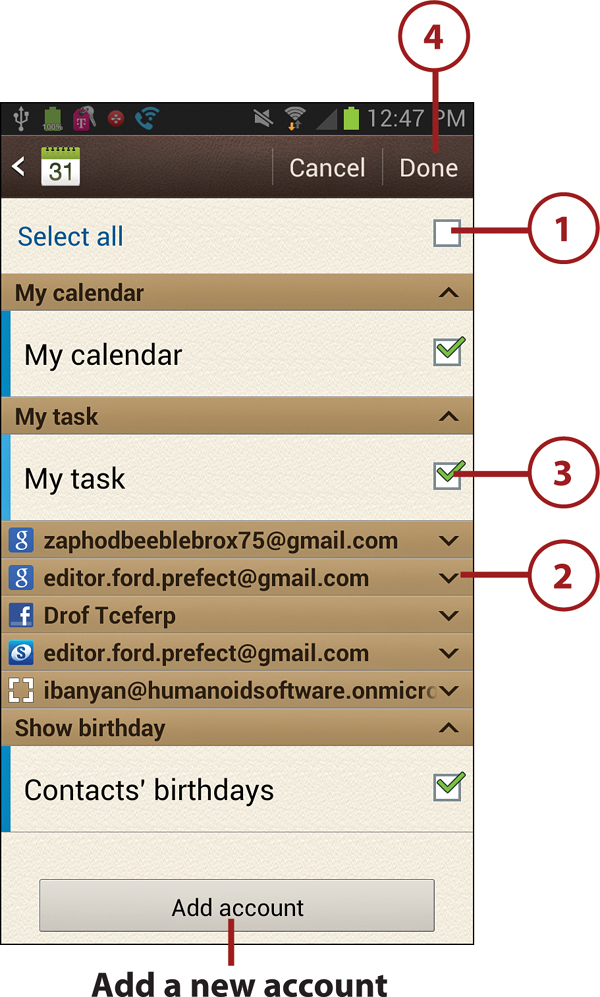
Change Calendar Settings
1. Touch the Menu button.
2. Touch Settings.

3. Touch to switch the way that the calendar shows events when you touch to view them in the Month view. Your choice is to have a pop-up showing the Event view or a list of the events at the bottom of the screen.
4. Touch to switch the way that the calendar shows the Week view. Your choice is to have a Timeline view where the days are across the top and the hours of the day are below, or an Analog view where the days are all shown on the screen at once.

5. Touch to set the first day of your week. You can choose Saturday, Sunday, or Monday. You can also choose Locale Default, which means the locale determined by the time zone you are in controls what the first day of the week is.
6. Touch to enable or disable hiding events you have declined.
7. Touch to enable or disable using your home time zone when displaying the calendar and event times. When this is enabled, your home time zone is always used even when you are not traveling in it.
8. Touch to set your home time zone if you enabled Lock Time Zone in step 7.
9. Touch to enable or disable showing the week number. For example, March 26th is in week 13.
10. Scroll down for more settings.
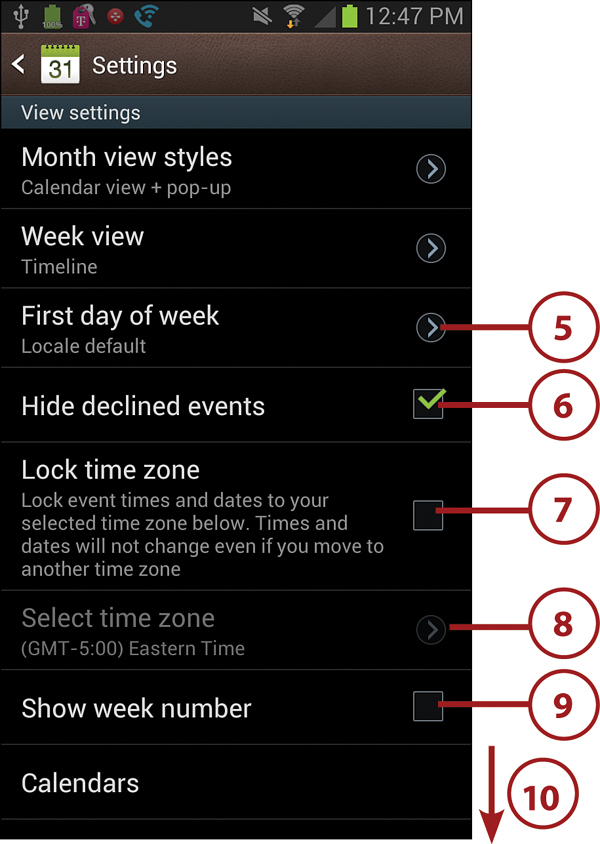
11. Touch to change how the calendar is displayed when you switch to Writing mode.
12. Touch to enable or disable notifications for calendar events. You can also set whether you are alerted in the Notification bar only or with a pop-up alert.
13. Touch to choose the ringtone to play when you are being alerted for calendar events.
14. Touch to choose whether your Galaxy Note II should also vibrate when the event ringtone plays.
15. Touch to set the default event reminder time.

16. Touch to enable or disable being alerted even when your Galaxy Note II’s screen is off.
17. Touch to edit the four built-in Quick Responses. Read more about Quick Reponses later in this chapter.
18. Touch to see an animation that shows how to use two fingers to change the Calendar view.
19. Touch to save your settings and return to the main Calendar screen.

Add a New Event
While you’re on the road, you can add a new appointment or event—and even invite people to it. Events you add synchronize to your Google and corporate calendars in real time.
1. Touch to add a new event.


A Quicker Way to Add an Event
You can quickly add a new event by touching and holding on the day on which you want to create the event and the time of day you want to create it.
2. Touch to select which calendar to add the event to.
3. Touch to enter a title for your event.
4. Touch to choose a sticker for your event. The stickers have images that help you visually categorize events.
5. Touch to select the start date and time of the event.
6. Touch to select the end date and time of the event.
7. Touch to select the time zone the meeting will be held in. This is useful if you will be traveling to the meeting in a different time zone.
8. Touch to mark the event as an all-day event.
9. Touch to set this as a recurring event. You can make it repeat daily, weekly, or monthly on the same date each month, but you can also set a meeting to repeat, for example, monthly but only every last Thursday regardless of the date.
10. Touch to add a new reminder.
11. Touch to remove a reminder.
12. Touch to change the type of reminder (Email or Notification) and how long before the event the reminder must trigger.
13. Scroll down to set more event settings.

14. Enter where the event will take place. This can be a full physical address, which is useful because most smartphones can map the address.
15. Enter a description for the event.
16. Enter the event guests, or event invitees. As you type names, your Galaxy Note II retrieves matching names from your Contacts and your corporate directory. If the email addresses you are typing are compleyely unknown, type a semicolon between them to separate them.
17. Touch to remove a guest.
18. Scroll down to set more event settings.
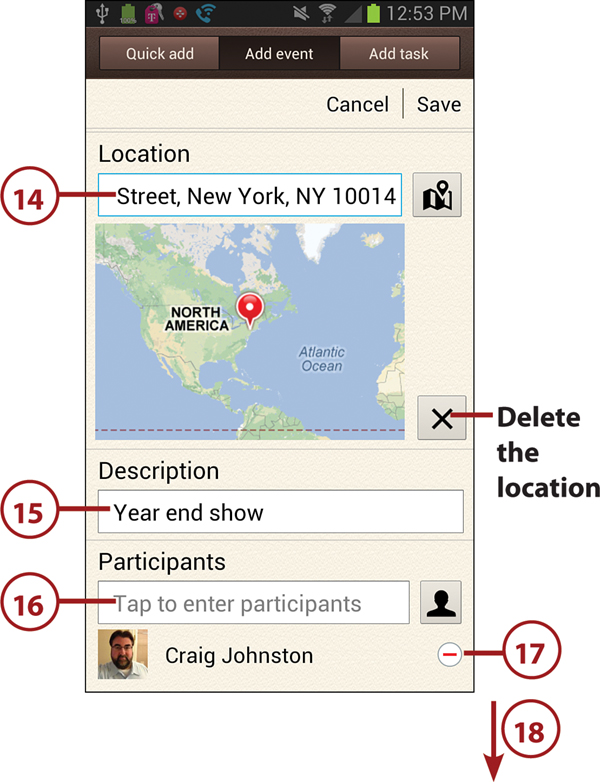
19. Touch to choose how to show your availability during this event. You can choose Busy or Available.
20. Touch to choose the privacy of the event. You can choose Public or you can choose Private so only you can see it. If the event is being created on your corporate calendar, setting the event to Private means that people can see you are busy, but they cannot see the event details.
21. Touch to link an existing S Note to this event or write a new one.
22. Touch to link an image from the Gallery app to this event, or take a new picture.
23. Touch to save the event. Any attendees that you have added are automatically sent an event invitation.

To edit or delete a calendar event, touch the event to see the event preview and then touch the event preview. After the event opens, touch the Menu button and choose either Edit or Delete. When you successfully delete an event, the Calendar application sends an event decline notice to the event organizer. So you don’t have to first decline the meeting before deleting it because this is all taken care of automatically.
Respond to a Google Event Invitation
When you are invited to an event, you can choose your response right on your Galaxy Note II in the invitation email itself, or you can use the Calendar app.
Respond from the Email
The Google event invitation email allows you to respond in the email itself.
1. Touch to open the event invitation email.

2. Touch Yes, Maybe, or No to indicate whether you will attend.

Respond from the Calendar
When you receive an invite, it is automatically inserted into your Google calendar but with no response selected.
1. Touch the new event.
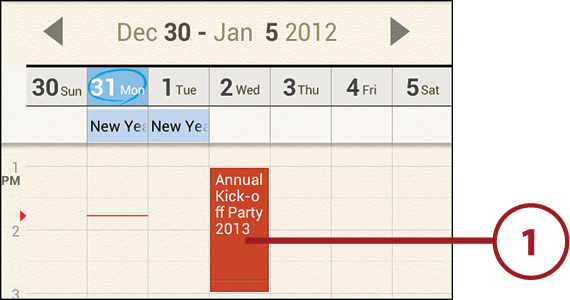
2. Touch the event location to have it mapped in Google Maps or another mapping app that you have installed (such as Google Earth).
3. Touch to send your response.
4. Touch to save your changes.
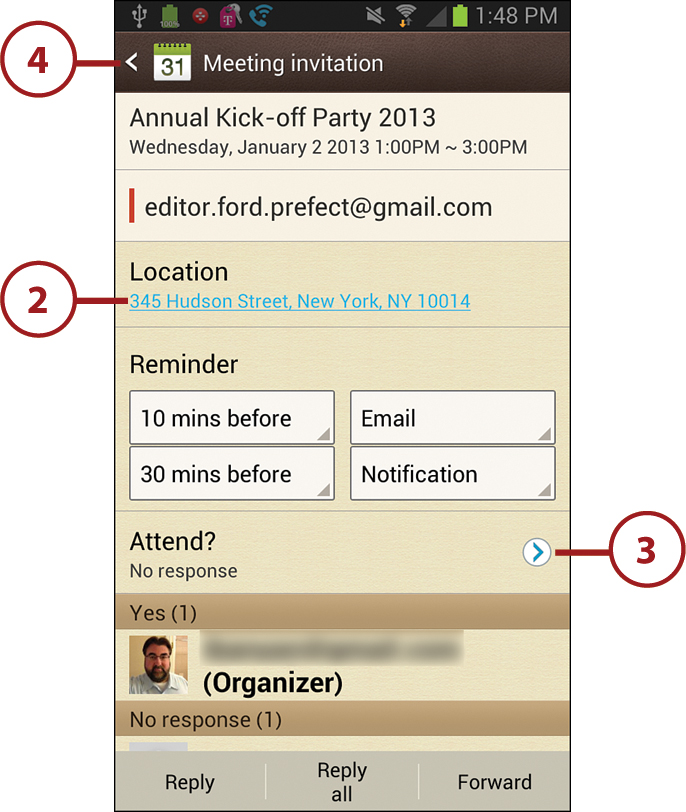
Respond to a Corporate Event Invitation
When you are invited to an event, you can choose your response right on your Galaxy Note II in the invitation email itself, or you can use the Calendar app.
Respond from the Email
Your Galaxy Note II allows you to respond to an event invitation in the email itself.
1. Touch to open the event invitation email.
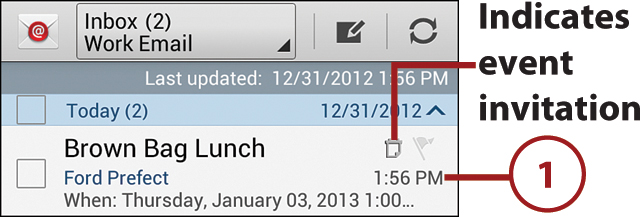
2. Touch to see the invitation responses.
3. Touch Accept, Tentative, or Decline to indicate whether you will attend. Alternatively, you can suggest a new event time.

Respond from the Calendar
When you receive an invite, it is automatically inserted into your Google calendar with the Tentative response selected.
1. Touch the new event.
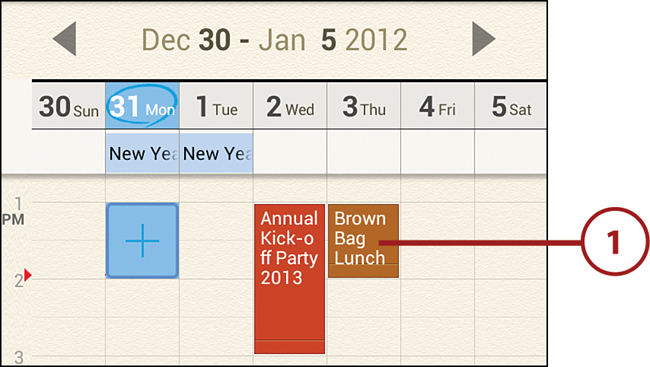
2. Touch the event location to have it mapped in Google Maps or another mapping app that you have installed (such as Google Earth).
3. Touch to choose your response or suggest a new time.
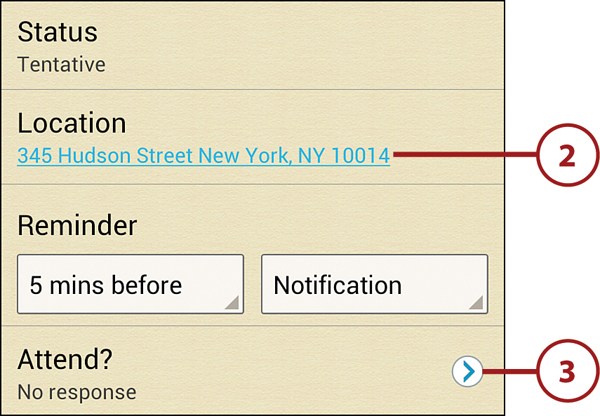
4. Choose Yes (Accept), Maybe (Tentative), or No (Decline). Alternatively, you can suggest a new time.

5. Choose whether you want to edit your response before sending it, send your response with no extra text, or do not send a response (your response is still recorded, just not sent).
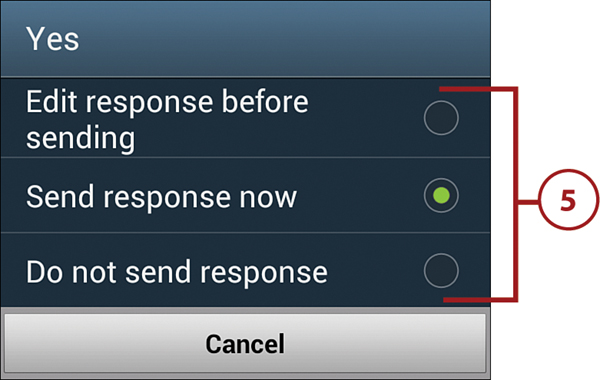
Use Quick Responses
When you are notified of an upcoming event on your Galaxy Note II, you can choose to Snooze or Email Guests. When you choose to Email Guests, you can choose a Quick Response to send them.
1. Pull down the Notification bar and touch to email guests.

2. Choose one of your Quick Responses or write a custom message. Read more about editing your Quick Responses earlier in this chapter.
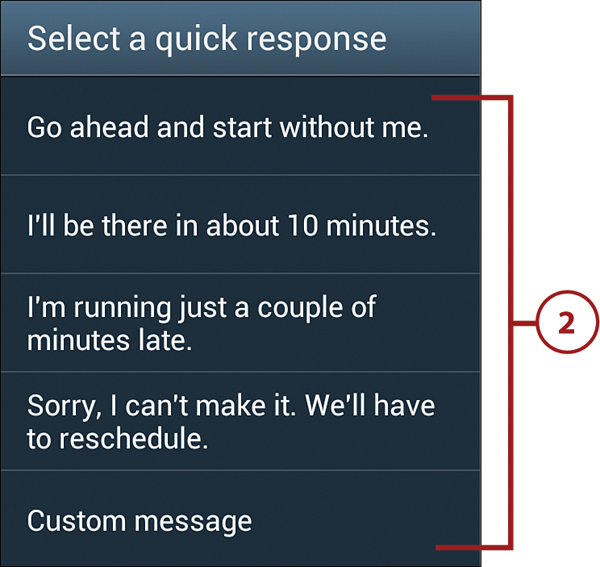
3. Choose which email app you want to use to send the Quick Response.
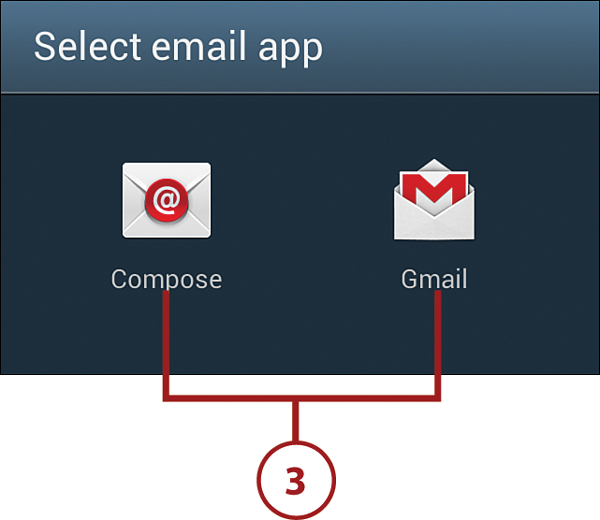
1. Touch to add a new task.
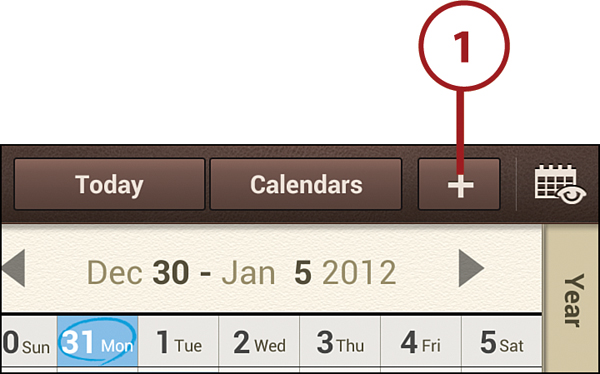
2. Touch Add Task.
3. Touch to choose which account the task must be added to.
4. Enter a title for the task.
5. Choose when the task is due.
6. Touch to choose when you want to be reminded of the task.
7. Touch to choose the task’s priority.
8. Enter a description for the task.
9. Scroll down to see more fields.
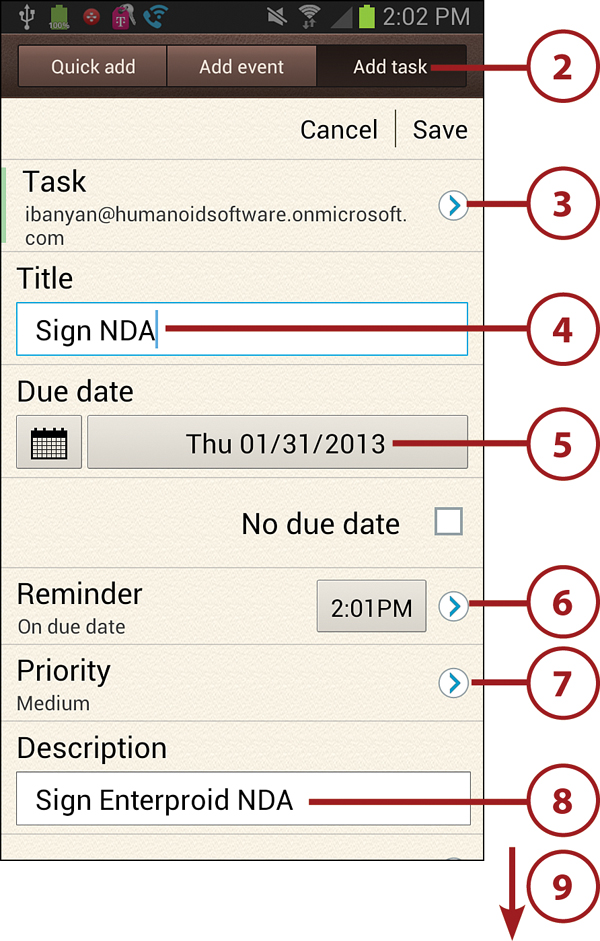
10. Touch to link an existing S Note to this task, or write a new one.
11. Touch to link an existing image to this task, or take a picture with the camera.
12. Touch to save the task.
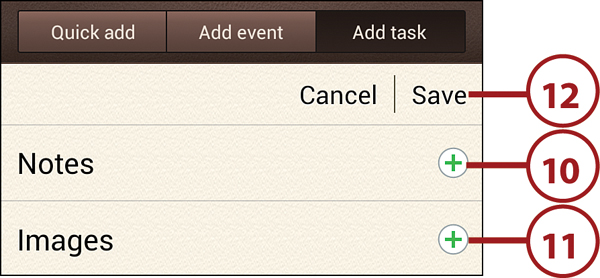
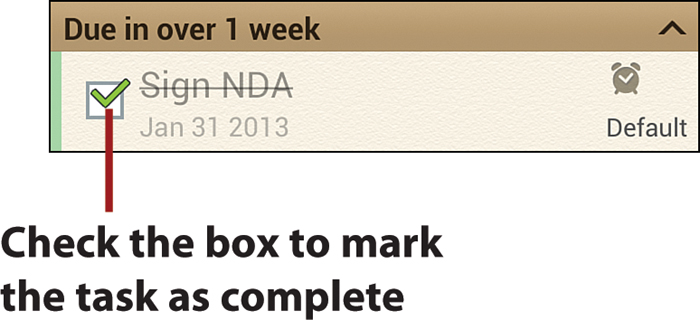
Marking a Task as Completed
To mark a task as completed, switch to Task view. Check the box to the left of the task to mark it as completed.

